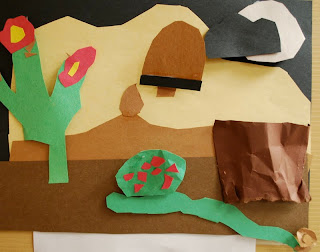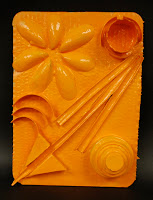This project was an experiment with my 4th grade students... Not in that we were doing a new lesson (we were,) but in how we worked on problem solving. I am sometimes too quick to just give students an answer when I should be challenging them to come up with their own solutions. I also purposefully did not make a finished example because I wanted the students to make their own choices instead of the same choices I made. Sooo, I explained the assignment (make a picture of a still life or landscape out of construction paper that is three dimensional) and showed the students a few techniques like tearing, curling, crumbling, folding, to create texture and dimension. I reminded the students that they might have to make tabs to attach the paper and let them get started. When a student asked me a question, I didn't answer it right away. I tried to ask them questions to guide them to a solution or encouraged them to ask classmates that looked successful what techniques they were using.
Honestly, this freaked out a lot of my students. I think if I work harder on questioning the whole school year instead of just trying it out at the end, it would go more smoothly. But hey, this blog isn't just about success stories, I'm trying to include my learning as I go.
This was a two class period project. At the end of the second class period, I had a student say, "Hey, this looks kind of cool at the end!" I guess that's why it's good to have a finished example, so the students can see where they are headed. I just get so frustrated when students copy my work because they think it is THE right way to do it. Even if I take the example down after I show it, I still have students with apparently photographic memories that copy it. And if I catch them in time, I make them change something so it's different than mine. Unfortunately, I don't always see it until they are mostly done!
I also touched on foreground, middle ground, and background to create space but it didn't click with most of the students. Something else I need to do a better job of next year!
 |
| This student incorporated mini origami birds which I love! |




















































